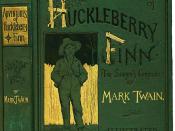In The Adventures of Huckleberry Finn, Mark Twain depicts the transition from Romantic thinking to an age of Realism, through the duality of the novel's two youthful friends Tom Sawyer and Huck Finn. Huck Finn and Tom Sawyer, although best friends, posses an entirely different outlook on life and demonstrate Twain's emergence as one of the greatest realistic thinkers of literary history. Through Huck Finn, Twain illustrates the realist and his analysis of the hardships that plague everyday life, while Tom Sawyer represents the romantic who sees life on a superficial level, seeking the love of adventure and self gratification.
Throughout the progression of the novel, the emergence of Huck Finn's realist reasoning displays Twain's transition from romantic thinking to a world of brutal struggles and oppressive themes. Huck Finn demonstrates his realistic thinking "where the current set in closest to the shore"(43), as he grabs a piece of bread floating down the river, which they intend to find his dead body with.
Huck's intelligence and reasoning demonstrates Twain and his belief that internal reasoning produces tremendous benefits rather the romantic beliefs that good fortune will come to those who need it. Huck Finn finds the bread, the bread does not find him, clearly criticizing the romantic movement and illustrating that threw knowledge and reasoning man creates his own path and holds his future within his hands. Another example of Huck's portrayal of realism occurs in his gradual appreciation of Jim and the black culture, as Huck grows increasingly close to Jim and sees that threw their relationship black people are equals. However, Twain depicts this change in Huck over the period of their whole journey, in contrasts to a seemingly instant, spontaneous change that would occur in a romantic world. Twain creates a realistic thought evaluation when Huck...


